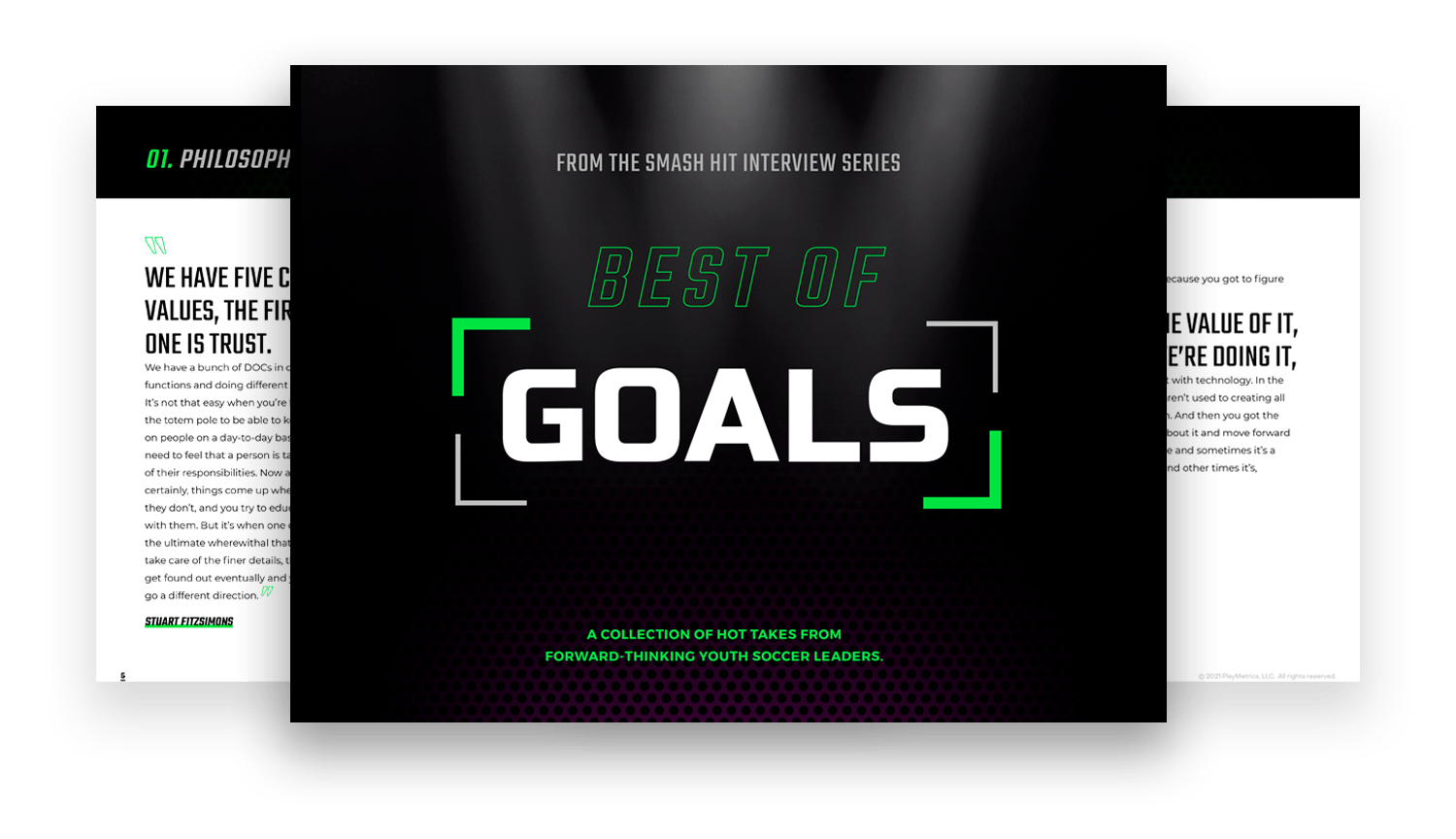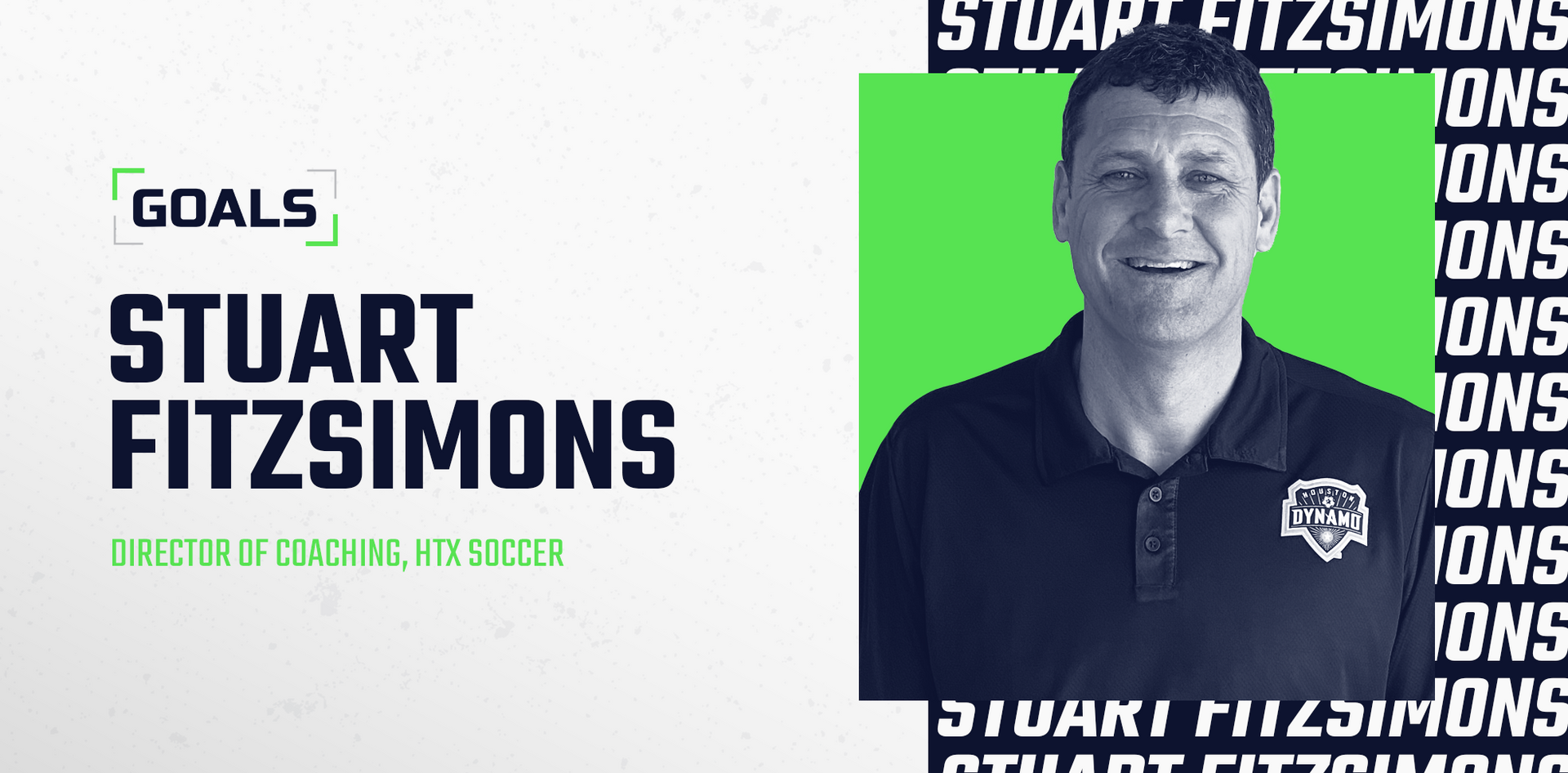It’s the question at the heart of every athlete’s journey: How far am I actually willing to go to pursue my passion? For some, the answer isn’t quite as far-reaching as they once hoped. For Stuart Fitzsimons, it’s much, much clearer: 4,601 miles.
That’s the distance – roughly – between Perth, Scotland, where Stuart began his love of soccer as a “coach’s brat,” and Houston, Texas, where he takes up residence as Director of Coaching for HTX Soccer (formerly Houston Dynamo | Dash Youth Soccer Club). Add to that a life-defining stop in Mobile, Alabama, and you’ve got yourself the story of a man determined to find his way in the soccer world.
It’s no surprise that a person who grew up serving as the waterboy and boot-cleaner for the local teams his father coached now spends his days training youth players and coaches in the art of showing up, taking responsibility, and doing one’s part to lift an entire team. He sees the sport through a wide-angle lens. He draws from his own experiences to teach, with passion, the joy in competition. He cares about the game, but more importantly, he cares about those around him – on the field and off.
In this interview, Stuart shares more on his journey, his transition from player to coach, and his grounded ideology on teamwork, competition, mental health, and more.
Interesting accent. Were you born in Scotland?
SF: I was actually born in England but lived there only a few days. My parents were both in the British Royal Navy and my father got stationed in Scotland so I grew up there. My mother was English and Protestant, my father was Scottish and Catholic which made for an interesting dynamic when growing up there in the 70s and 80s. The two biggest soccer clubs in Scotland being Celtic F.C. on the Catholic side, and Rangers F.C. on the Protestant side. We had a lot of issues with what was going on in Northern Ireland and the Republic of Ireland. The Troubles, thankfully, no longer exist and it’s a much better situation now. Supporting Celtic F.C., Kenny Dalglish was my boyhood hero. And then it morphed into being Alan Hansen, the Scottish central defender who played for Liverpool. That was my position, central defender.
When did you start playing?
SF: My Uncle Brian started taking me to the local park to kick a ball around when I was three years old. I was very young, but I do have a vision in my head of being at the park and wearing a Hibernian FC shirt with green and white sleeves.
Good memory.
SF: My dad was a semi-professional player and then became a coach. I was the coach’s brat that followed him around everywhere. I was the waterboy, the ball boy, I cleaned the boots. I started kicking around in preseason with the players when I was 12 or 13. That’s all I wanted to do. I was an average student at best, and soccer was 10 months out of the year. And then I played a little bit of golf in the summers.
You’ve had quite the journey, literally, to get to Houston. How did that young boy from Scotland end up at the University of South Alabama?
SF: I wanted to study physical education, but there was only one college in Scotland, Jordan Hill College in Glasgow, that offered it. Every year they would have 20 to 25 spots and thousands of kids like me trying to get in. So if you weren’t a straight-A student or if you had not represented Scotland at a national youth level in whatever sport you were in, it was going to be very difficult. I tried for two years to get in.
By the time I was rejected the second time, my father met a gentleman through work whose son had come over to the US and attended the University of South Alabama (USA). We got hooked up with the coach at USA at the time, Roy Patton, and a month later I was on an airplane with my golf clubs and two bags headed to Mobile. It was one of the best decisions I’ve ever made in my life.
That’s a big change beyond just geography. How did you adjust to playing at USA?
SF: It was a bit nerve-racking traveling to the other side of the world when you don’t know a soul. But it brings many great life experiences. I came over not knowing much about the process of becoming eligible to play and meeting the academic requirements. I had not taken an SAT or ACT exam before I started school so I was ineligible for the first year under Prop 48 in those days. A redshirt. It actually worked out in my favor because when I first came over at 6 foot 3, 155 pounds, I was a stick. I had plenty of talent but was struggling physically especially in the 100-degree summer heat in Mobile. So I basically spent a year in the weight room. I hammered away at it, six days a week, and by the next pre-season, I was 6’5 and 205 pounds, and a completely different physical athlete.
It was a bit nerve-racking traveling to the other side of the world when you don’t know a soul.
Did you still find a way to get in playing time during that year?
SF: I got involved with some men’s leagues and played on weekends. Being a port city, Mobile has a pretty diverse community. There were plenty of South and Central Americans who loved the game, and even a few of us expats from back home. By that spring, I was able to get into school, get with the team, and blossom from there.
We had a really good team over the years. In my first year, which was ‘89, it was arguably our best team going 19-1. The only game we lost was to Howard who had Shaka Hislop playing in goal.
And then a few years later, you’re back in Scotland.
SF: I played three years, hadn’t finished my undergrad, but I decided at 22-years-old if I was going to try and make it in the pros, I needed to go do it. I knew I would always go back and finish school but I decided to go home. Roy hooked me up with a club in Northern Ireland. I started there, did very well, got noticed by some scouts, and ended up going to Partick Thistle on trial. Played against some fantastic players at the time, and did well, but unfortunately, they decided to sign a player who had more experience at that level, a central defender from another club in the Premier League in Scotland.
I then went down to Stockport County F.C. in England, which is just outside of Manchester, and at the time they were banging on the door trying to get out of the English Second Division. They signed me but just after, I broke my left big toe and was out for three and half months. And then after the toe injury, I had more knee problems. It was the end of the 92-93 season and the writing was on the wall. I was 24 competing against 18, 19, and 20-year-olds. It was time to come back to America where I finished my bachelor’s degree, started my master’s, rehabbed my knee, and started playing again in the USL.
I played with a local team in Mobile, and also in New Orleans while I was finishing my master’s. I then went to Richmond with The Kickers and met Dennis Viollet. A “Busby Babe,” Dennis was a famous player at Manchester United in the 50s and 60s and a survivor of the Munich Air Disaster. A fantastic gentleman. I played for him in Richmond and then the following year with the Jacksonville Cyclones. From there, I became the head coach at USA after Roy left.
What was it like being back in Alabama as head coach?
SF: It was tough to begin with. There was a big senior class in Roy’s last year, and while there was some recruiting done, there were only four or five players left from the previous team. So the first year we had kind of a pseudo club team where we did tryouts to make up the roster. We brought in 19 kids the following year, made it to the conference championship, and then in my second year, we won the Big South Conference Championship. This is with two seasons of kids, mostly sophomores and freshmen we developed through that time.
How did you continue to progress your coaching career?
SF: I became director of a club in Birmingham, Alabama called Vestavia Hills Soccer Club, which was one of the more recognized and developed clubs in the area. We had a lot of success getting kids to play in college, and also had a couple of kids make the pro level. One of those kids, Floyd Franks, went on to play in the MLS with Chicago Fire.
From a small state like Alabama to get anybody to that level was very good. It was a great three years, but I felt that I needed new opportunities to learn, not just about the soccer side but about the business side of it. It was obvious that the development of youth soccer was going in a positive direction from the standpoint it was becoming more professional. But a professional business is different than becoming a professional, technical-driven soccer pursuit, if you will. There are a lot of things that go into running a youth soccer club that I think the average person doesn’t understand.
What’s the soccer vibe in Houston, Texas?
SF: Houston, historically, is an American football and baseball town. But I think the growth of soccer, particularly the female side of the game started to grow 15-20 years ago, and that propelled the game quite a bit. Houston is a hugely diverse city now, so as a soccer community, I think Houston is very much a sleeping giant. Based on our population size, we need to find more success in players from the youth level making the National team or going into the pros. We haven’t had as much of that as Dallas or parts of California or parts of the northeast. You can look at it in a negative way and say we’re behind, and there’s a fair argument to that point, but I think from the standpoint of where it was 20 years ago. I’ve been in this city for 18 years now, and from where it was then to where it is now, there are far more kids playing, both genders. There’s a far more diverse community involved with the game, and I think the talent is there and it’s just a matter of getting the talent with good coaching.
Houston is a hugely diverse city now, so as a soccer community, I think Houston is very much a sleeping giant.
Tell us about HTX Soccer.
SF: We were Texas Rush Soccer Club, and about five years ago started a license agreement with Houston Dynamo to run youth soccer programming within a 100-mile radius of the Greater Houston area. We provide programming from little tots of three or four, rec level, all the way to 18/19 elite, competitive, recreational level. We have hundreds of volunteer coaches, about 40 full-time employees, and when you take it all in and add part-time coaching staff we’re probably at about 120.
When we were Texas Rush we had just over 3,000 kids. We now have nine locations and are up to about 7,500–8,000 kids. We had a couple of clubs join in with us. One on the south side of town, Space City, jumped on board. And then we have another partner that came in from the Beaumont area. They have been doing a great job and it’s been an interesting dynamic of trying to put all these personalities and entities together. Every day you’re learning something from someone new.
Do you still get to coach in your role as a director?
SF: For the first six years, I did a mix of coaching and administrative work. My world is a lot more admin now though I still coach. If I only focused on the admin side and didn’t do any coaching, it would drive me insane.
If I only focused on the admin side and didn’t do any coaching, it would drive me insane.
As you mentioned, that’s part of learning the business side of running youth soccer. Did you have any idea what you were getting into with administrative work?
SF: Not at all. Like I said earlier, the way youth clubs have gone now, if you don’t become a professional business with a professional organization and structure, it’s going to be very difficult for you to survive and be successful. You still see it out there in smaller clubs with a handful of guys running them. They seem to be enjoying it. They spend a lot of time on the field but are they doing all the off the field stuff? Admin, marketing, communications with your membership, and all that stuff. You can see the difference between clubs who are and clubs who are not.
What is something those clubs should start doing?
SF: Originally when we started Texas Rush, email was the big thing. That was your major communication vehicle. Now, it’s Instagram, Twitter, Facebook. It’s all of those things, and if you can’t communicate in those forms on a daily, or to some extent, hourly basis, you’re behind the eight-ball.
What’s your approach to developing coaches?
SF: To a certain extent, it’s throwing people in the deep end and seeing how they do. Us old guys, that’s what we had to do.
We have five core values, the first one is trust. We have a bunch of DOCs in different functions and doing different things. It’s not that easy when you’re further up the totem pole to be able to keep checking on people on a day-to-day basis, so you need to feel that a person is taking care of their responsibilities. Now and again, certainly, things come up where it shows they don’t, and you try to educate and work with them. But it’s when one doesn’t have the ultimate wherewithal that they want to take care of the finer details, they typically get found out eventually and you have to go a different direction.
Care is another big word in our organization, both from the standpoint of on-field and off-field. So when you’re looking at coaches from an on-field perspective, do they care about the kids, do they develop a relationship with the kids where it shows that they care? Now, care can be defined in a lot of different ways. As a coach, there are times where you’ve got to put an arm around a kid and care that way, sometimes you have to be fairly tough with them and get after them a little bit because ultimately, this is a competitive environment and you are expecting them to compete. There’s that knowledge, experience, of knowing which player needs the arm and which player needs the toughness and being able to balance that.
Identifying people who know the difference, and especially with younger coaches, can be difficult. And then you educate them to understand when you need to be a little bit tougher versus being nice if you will. To be nice all the time will eventually mean that the kid pushes the boundary, which then could affect your team dynamics.
What’s one of the biggest challenges you face managing coaches?
SF: The one thing we have had trouble with at times is an established coach coming in, who was historically involved in just on-field stuff and are then asked to do administrative work. All of our full-time staff is involved administratively in the club. Our board makes sure financially we don’t disappear, but for day-to-day operations, our technical staff is making the decisions. With that responsibility comes autonomy, right? How and when you do it, we’re not necessarily going to be checking on you, but is it getting done? And that’s where we had some trouble with some good coaches who are well-established but weren’t willing to get after doing the admin work to support that or were expecting other people to do it for them. Those are the kind of characters that we’ve had to weed out, for lack of a better word, to be able to make our organization progress forward.
How have those experiences with coaches shaped how you go about hiring new ones?
SF: Obviously, you want them to have some kind of background in the game whether they played in high school or at a college level. That’s ideal. Showing the interest and the wherewithal to go and get licenses and get that experience is a big positive. Are they self-motivated? Do they want to improve themselves? That’s number one, I think.
Second, going back to the care issue, when you talk to people and get references, have they shown a real desire to make a difference? Do they really care about the kids and want to make an impact in their lives? On the business side, do they have the skillset and comfort level to do the computer work and use the software you need to pull stuff together. Are they willing to learn and make the most of the platforms?
Give us some of the less than glamorous responsibilities you have as a director of coaching?
SF: It’s mind-boggling the details that need to be taken care of behind the scenes so that members can register, show up, and enjoy the experience that you’re trying to provide. We have this thing here, “Soccer Never Sleeps.” It’s a 24/7/365 occupation. I deal with a lot of putting out of fires, whether it be working with the local parks to get fields booked, and then being in some kind of mix-up between communications, or dealing with parents that might have an issue with a coach. There are so many little details that take up your time. Because of that, you want your group, your staff, to be educated and informed. You want to be there for them. The reality is like anything else, there’s only so much time and time is our most precious commodity. Trying to navigate that at times can be very frustrating.
What positive trends in parent engagement have you noticed?
SF: There’s a greater understanding of the game, so you have a bigger percentage of parents understanding that this is a process of learning, versus “I’m only going to be happy if we win.”
Mental health has become a bigger issue. You’re starting to realize from a mental health standpoint that kids are human beings, not robots. Coaches are human beings, we’re not robots. There’s a greater understanding that this is a long-term process. I don’t have a lot of experience with American football, baseball, or basketball, so I don’t know how they are learned. But my general perception is soccer’s a little bit harder to learn because it’s a game that flows. A basketball coach can call a timeout. A coach in American football is calling a play every 10, 15 seconds. Baseball is the same kind of thing.
Soccer takes longer to learn because there’s never one situation that’s the same, whether it’s in training or a game situation. And yes, there are general principles, but there are always different solutions that can arise during the game and the player has to figure that out very quickly. There’s a lot more responsibility on the player’s shoulders. And that’s why I think it’s the best game in the world to play because ultimately it is the players that have the biggest impact on the outcome of the game. It’s not necessarily play-calling, and you don’t get to take time to strategize what you’re going to do next.
What do you think young players need to learn beyond the technical, physical side of soccer?
SF: As a coach, we’re sharing information during the game, but to some extent, you don’t want to be doing too much of that because it’s like you’re giving them the answer. You want the kid to be able to learn the answers themselves. Sometimes they’re going to fail, but the reality is you learn a lot more from failing. It’s not the end of the world to fail.
First is let’s compete, and competing is different from winning and losing. Competing is learning skills. Competing is learning how to pass the ball. Competing is learning how to mentally be ready to play. Competing is learning different skills and how to use them in different tactical situations. Competing is in the decision-making of the game.
You’ll get some families that are what we call “club hoppers.” They will be at one club and, “It’s not right for my kid ’cause the team’s not winning” or, “He’s not going to be pushed,” and they go to another club. Over a space of four or five years, they may have been at four or five different clubs. Realistically the kid’s ability to learn is being diminished, because they’re changing things all the time, and there’s no consistency to what they’re learning.
Competing is different from winning and losing. Competing is learning skills. Competing is learning how to pass the ball. Competing is learning how to mentally be ready to play. Competing is learning different skills and how to use them in different tactical situations. Competing is in the decision-making of the game.
What is your take on how youth soccer is addressing more advanced ways of learning the game?
SF: It’s a pity what happened just before COVID with US Soccer pulling the plug on the Academy Program. I think one of the biggest pluses that came out of that was the whole development of the curriculum. If you look across the country, the bigger established clubs have a formalized curriculum. Again, soccer takes time to learn. So there are things you need to learn when you’re nine, 10, 11, 12 that don’t really make a big impact on whether your team wins or loses. I think at times that is lost on the average parent, who comes on the weekend and gets all fired up and feels good about winning versus were they paying attention, did their son pass the ball properly, did their daughter make the right decision in a situation? That’s where I think it will be interesting to see in the next five or six years now that there’s no more Academy Program. How that affects curriculum development, which then affects coaching education, which then affects the product of coaching to the players.
What new technology has fundamentally changed coaching for you?
SF: The ability to create a curriculum, create sessions, and then pass it to your staff to use in training, ultimately improving the product for the player. I think there are many different platforms and vehicles to do that. PlayMetrics has been fantastic from the standpoint that you can do all of the business and admin with it, but you also have this curriculum component to it as well, which helps in every facet of a DOC’s job, and full or part-time coach’s job. We’re all on the same page from a curriculum basis, and we can now really mandate that as a club and push forward our philosophies, our style of play, the formations, and our core values. All of that can now be put forth to every staff member.
Do you ever meet resistance getting coaches into a new way of doing things?
SF: Not with the new guard. They’ve grown up in an environment where there’s been a lot of technical stuff around them, and they realize that it’s part of what they have to do. They’re all pretty savvy with things. You have some guys that now are so savvy with the Zoom calls. They’re not just doing general dialogue, they’re providing PowerPoints and doing video analysis on Zoom. While we were locked down, we created a new YouTube page with a lot of video content. We were doing fitness or skills sessions on Facebook. And that’s all our younger guard leading the journey. It’s been very interesting to see how it’s put together. And because I had a bit of time sitting at home, I could learn more of that kind of stuff. That’s been a positive out of all of this for me.
There are a lot of smaller clubs out there looking to grow. Any advice for them?
SF: You have to understand that youth soccer is a service industry, and you are there to serve people. You have to get your background organization running efficiently. And if you can get the business side, the organizational side, the logistical side, organized and structured, you have more time to go enjoy the stuff that you really want to do. Create the things that are going to help make your service on the field better. Whether it be curriculum development, educating coaches, the final product with the players, or the ability to teach the game better.
You have to understand that youth soccer is a service industry, and you are there to serve people.
What is most rewarding for you in working with young athletes?
SF: Ultimately seeing players enjoy competing. When they really get the aspect of putting it all together and going out and being successful on the field. Playing and seeing that, “Oh, that’s how you do it, that’s what he meant, that’s how the game needs to be played, or that’s how I need to do my job and take care of my responsibilities.” That kind of light bulb coming on. Awakening is maybe too strong a word, but that general thought process of matching a group together where they realize that the ‘All’ is more important than the individual. That ultimately is, I think, the biggest impact and why soccer is the greatest game ever.
I look at my own experience. Going to college I played with players from Europe, South America, Central America, North America, a whole hodgepodge of people, and we all had one common goal which was passion. The love of competing together and by doing it together you get far more out of it than you do if you just want to do your own thing. I think when kids really get it, and understand that if they give and everybody else gives, the actual individual gets more out of it. Because you’ve got 15, 16 people giving to you so there’s no way you’re not going to get more out of it than if you were doing it yourself.
The beauty of team sports.
SF: That to me is the essence of team sports. And then taking that experience as a kid, and using it in the bigger picture. Understanding that you can’t get through life without working in a group environment in any profession whether it’s as the garbage man or the best heart surgeon in the world. Everyone has got to come to the game, so to speak, and take care of their responsibilities. If everybody does that then everybody can be successful. It’s when that light bulb comes on and they understand the bigger picture is ultimately what this is about.

A powerhouse of insights from some of the most forward-thinkers in youth sports. Download Best of GOALS.
Recent Posts





